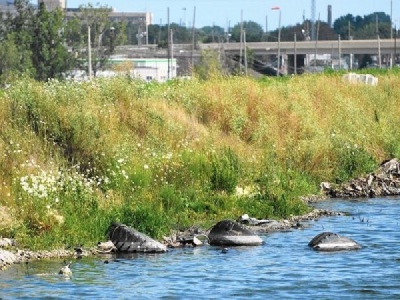
Posted on August 7, 2017
By Javonte Anderson, Post-Tribune
East Chicago remains a concern for local environmentalists as public outcry has temporarily stalled the U.S. Army Corps of Engineers from receiving a permit that would allow storage of toxic sludge from the Indiana Harbor and Shipping Canal in the city.
For longtime environmentalist Colleen Aguirre, it’s familiar territory. She was part of the opposition to the Army Corps establishing a confined disposal facility (CDF) site in East Chicago before the project started in 2012.
“We knew then that we didn’t want this project,” said Aguirre, a longtime community activist and former member of the East Chicago Waterway Management Board.
“I fought them for decades and of course, now they say they want to store even more toxic stuff in the CDF,” she said. “This didn’t surprise me.”
In 2014, the Army Corps applied for a permit that would allow the disposal of toxic sediment from the canal containing PCBs into the CDF at 3500 Indianapolis Blvd. To date, the Army Corps has not been allowed to dredge the most toxic locations in the canal because they don’t have the authorization to store it at the facility in East Chicago.
These “hotspots” have been sitting in the canal for decades, officials said. The permit the Army Corps is seeking would allow them to dredge and store this toxic material for the first time. Approval of the Army Corps application would make the confined disposal facility a permitted hazardous waste storage facility.
The U.S. Environmental Protection Agency is still reviewing public comments and has not yet made a decision on whether it will issue the Army Corps the permit, according to EPA officials.
While there continues to be environmental concerns among some groups, an Army Corps representative vouches for its safety.
The two cells on the site are both 45 acres and are surrounded by dikes built of “impervious clay” to contain the dredged sediments, said Natalie Mills, the Army Corps’ manager for the Indiana Harbor and Canal dredging project.
There are several safeguards in place — including a groundwater protection system — to monitor the water levels in the CDF and to ensure the water does not leave the site, Mills said.
“The entire design of this facility was considered that this material is contaminated and we have to make sure that this project is safe to the community,” she said.
Since the Army Corps resumed dredging in 2012, more than 1 million cubic yards of sediment has been removed from the canal, Mills said. The Army Corps stopped dredging in 1972 because there wasn’t a suitable storage place for the contaminated sediments.
“Our job is to restore and maintain the navigational depth of Indiana Harbor and its channels,” Mills said.
Despite owning the property where the CDF is located, the East Chicago Waterway Management District recently passed a resolution expressing opposition to the Corps storing the dredged material from the canal in East Chicago.
“We want the material removed out of the canal but we want it to be reviewed anywhere other than the CDF,” Fernando Trevino, the Waterway District’s executive director, said.
The Waterway District wrote a letter in March addressed to the Indiana Department of Environmental Management and the U.S. Environmental Protection Agency expressing concerns with the Army Corps storing more toxic material at the site in East Chicago.
The district’s primary concerns are the site’s proximity to East Chicago schools and nearby residences and the district’s ability to reuse the land after the site is closed.
The sediment is removed from the canal using a mechanical dredge. The dredged material is then loaded onto barges where it is transported back to the CDF site on the north side of the canal. The sediment dredged from the canal is then mixed with water to make a semi-liquid mixture, Mills said. The slurry is then pumped into a cell, which looks like a pond.
After five years of cleaning, residents are not convinced that dredging the contaminants out of the canal and storing them at the open-air facility is good for the residents and the environment.
The CDF is less than a mile away from the new Carrie Gosch Elementary School and East Chicago Central High School, both at Indianapolis Boulevard and Columbus Drive. When standing on the site, Central High School’s gymnasium is visible through the towering trees.
In recent weeks, the opposition to the Army Corps receiving the permit has grown louder, including a local environmental advocacy group protesting in front of U.S. Rep. Pete Visclosky’s Merrillville office.
The Army Corps has a plan to mitigate the environmental impact if it receives the permit that would allow it to store more toxic contaminants, Mills said. She said the plan calls for the Corps to layer the material with higher PCB levels with less contaminated material limiting its exposure to the environment.
“I definitely understand (people’s) concerns but we’ve done a lot of planning in anticipation of the receipt of the (more toxic) material,” she said. “So we have added all of these features to this project just to ensure this is safe to the community.”
Despite the safeguards, some residents and activists remain skeptical.
“Look at the response,” Aguirre said. “The people don’t want that stuff there.”
Source: Post-Tribune





